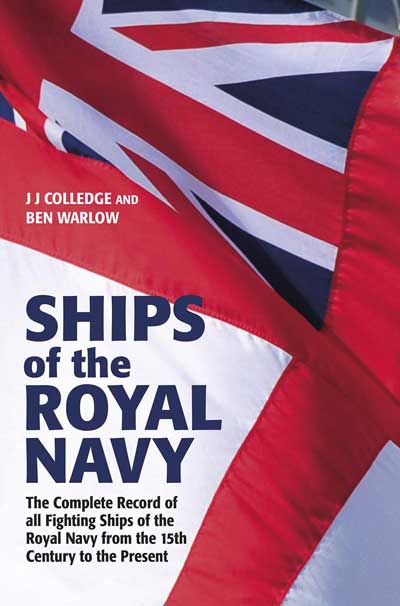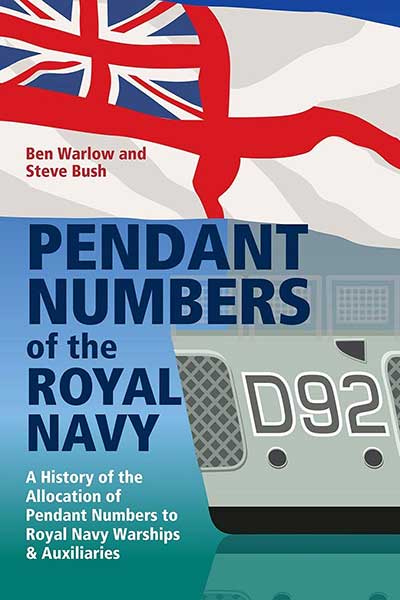Ships of the Royal Navy: The Complete Record of all Fighting Ships of the Royal Navy from the 15th Century to the Present
J.J. Colledge, updated by Ben Warlow & Steve Bush
Pendant Numbers of the Royal Navy: A Record of the Allocation of Pendant Numbers to Royal Navy Warships and Auxiliaries
Ben Warlow & Steve Bush

 The fifth edition of the late J.J. Colledge’s Ships of the Royal Navy is a valuable update of this standard reference work, first published in two volumes in 1969 and 1970. This latest version, revised and updated by Ben Warlow and Steve Bush, adds information for all the most recent warships commissioned into the Royal Navy since the previous edition in 2006. It also incorporates, for the first time, the ships of the Royal Fleet Auxiliary, a reflection of the fact that these vessels, although not commissioned warships, have come to play a vital role when deployed as integral elements of the Royal Navy’s task forces worldwide.
The fifth edition of the late J.J. Colledge’s Ships of the Royal Navy is a valuable update of this standard reference work, first published in two volumes in 1969 and 1970. This latest version, revised and updated by Ben Warlow and Steve Bush, adds information for all the most recent warships commissioned into the Royal Navy since the previous edition in 2006. It also incorporates, for the first time, the ships of the Royal Fleet Auxiliary, a reflection of the fact that these vessels, although not commissioned warships, have come to play a vital role when deployed as integral elements of the Royal Navy’s task forces worldwide.
Readers of this edition who are accustomed to the format of the previous versions will find little has changed, in terms of the presentation of the data, from Colledge’s original ground-breaking work. Since all such information is in a highly condensed form, it is essential to read carefully and thoroughly through the introductory sections to gain the full benefit of this mass of data, which covers the more than 15,000 vessels that have served in the Royal Navy since the fifteenth century.
Pendant Numbers of the Royal Navy, on the other hand, is a completely new title. Since it and Ships of the Royal Navy were published within a few months of each other and present complimentary information, it seems appropriate to consider them together.
The practice of painting pendant numbers on the hulls of ships of the Royal Navy began in 1914, but the numbers themselves pre-date that practice considerably. The very large size of the Royal Navy in the late nineteenth century led to the allocation of individual numbers to each ship for administrative and identification purposes. While signaling using flags, these numbers were used to direct messages and the fact that a number was being signaled was indicated by using a pendant, a triangular flag. Hence, when the numbers came to be marked on ships, they were called pendant numbers.
This new book will be an invaluable tool for researchers, since it lists all known pendants numbers for surface ships and submarines, and has a supplement covering numbers allocated to the vessels of the British Pacific Fleet in 1944-1945. Thus facilitating identification of ships from photographs on which the numbers are visible. It is important to note that pendant numbers were changed periodically, specifically to confuse enemy intelligence, unlike the hull numbers used by the United States Navy, which changed only if a ship changed its role. There also is a complete list of ships by name with each ship’s pendant number or numbers, and the dates for which these were applicable. This could be useful for model makers or artists planning a model or painting but unsure of the correct number for the date they wish to depict.
Ships of the Royal Navy and Pendant Numbers of the Royal Navy should find a prominent place on the shelves of any self-respecting researcher.
Ships of the Royal Navy: The Complete Record of all Fighting Ships of the Royal Navy from the 15th Century to the Present
- Barnsley: Seaforth Publishing, 2021
- Annapolis: Naval Institute Press, 2021
- 6-1/2” x 9-1/2”, hardcover, xx + 500 pages. $39.95
- ISBN: 9781526793270
Pendant Numbers of the Royal Navy: A Record of the Allocation of Pendant Numbers to Royal Navy Warships and Auxiliaries
- Barnsley: Pen & Sword Maritime, 2021
- Annapolis: Naval Institute Press, 2021
- 6-1/2” x 9-1/2”, hardcover, xviii + 432 pages
- Photographs, appendices. $44.95
- ISBN: 9781526793782
Reviewed by Denis Wilkinson, San Diego, California
